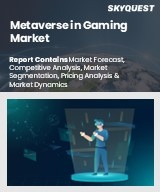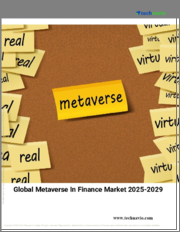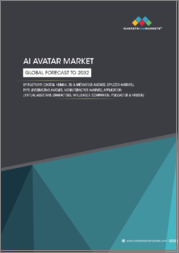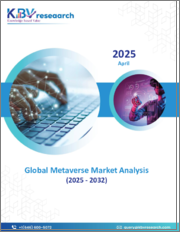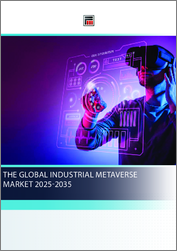
|
시장보고서
상품코드
1734804
세계의 메타버스 시장 예측(-2032년) : 컴포넌트별, 플랫폼별, 기술별, 용도별, 최종사용자별, 지역별 세계 분석Metaverse Market Forecasts to 2032 - Global Analysis By Component, Platform, Technology, Application, End User and By Geography |
||||||
Stratistics MRC에 의하면, 세계의 메타버스 시장은 2025년에 1억 7,958만 달러에 달하고, 예측 기간 중 연평균 복합 성장률(CAGR) 46.3%로 성장하여 2032년까지는 25억 7,608만 달러에 이를 것으로 예측됩니다. 메타버스는 물리적 현실과 디지털 현실이 융합되어 만들어진 집합적 가상 공간으로, 가상현실(VR), 증강현실(AR), 3D 환경과 같은 몰입형 기술을 통해 사용자가 상호 작용할 수 있도록 합니다. 이를 통해 실시간으로 사회적 상호 작용, 업무, 엔터테인먼트, 상거래 및 디지털 자산 소유가 가능합니다. 인터넷의 진화라고도 불리는 메타버스는 사용자가 상호 연결된 플랫폼에서 생활하고, 게임을 즐기고, 비즈니스를 수행할 수 있는 지속적 가상 세계를 통합합니다.
Deloitte에 따르면, 메타버스는 2035년까지 연간 8,000억 달러에서 1조 4,000억 달러의 아시아 GDP에 기여할 수 있다고 합니다.
몰입형 경험에 대한 수요 증가
VR, AR, 혼합현실(MR)의 발전으로 인한 몰입형 경험에 대한 수요 증가는 메타버스 시장의 주요 성장 요인입니다. 게임, 엔터테인먼트, 가상 부동산 등의 산업은 이러한 기술을 활용하여 인터랙티브한 환경을 구축하고 사용자 참여를 높이고 있습니다. 또한, 기업들은 가상 협업, 제품 데모, 고객과의 소통을 위해 메타버스 플랫폼을 채택하고 있습니다. 초현실적인 디지털 경험으로의 전환은 인터랙티비티에 대한 소비자의 기대치가 높아지면서 메타버스 인프라에 대한 투자를 계속 촉진하고 있으며, 디지털 혁신의 선두주자로서의 역할을 확고히 하고 있습니다.
표준화 부족
독자적인 기술과 파편화된 생태계는 호환성 문제를 야기하고, 가상 환경 간의 원활한 사용자 전환을 제한합니다. 또한, 디지털 자산의 소유권 및 거래에 대한 규제 프레임워크가 없기 때문에 불확실성이 증가하고 있습니다. 이러한 파편화는 통합의 복잡성과 잠재적인 락인(lock-in) 위험으로 인해 기업의 채택을 방해하고, IEEE와 같은 조직이 표준화를 위해 노력하고 있지만, 진행 속도가 느려 단기적인 성장을 저해하고, 통합된 크로스 플랫폼 생태계로서의 메타버스의 잠재력을 방해하고 있습니다. 방해하고 있습니다.
교육 및 트레이닝을 위한 메타버스
메타버스는 몰입형 시뮬레이션과 가상 교실을 통해 교육 및 기업 교육에 큰 기회를 제공합니다. 교육 기관과 기업은 VR 기반 환경을 활용하여 복잡한 기술을 가르치고, 의료 교육을 실시하며, 실제 시나리오를 비용 효율적으로 시뮬레이션할 수 있습니다. 또한, 세계 접근성을 통해 원격 학습이 가능해지면서 교육의 민주화가 진행되고 있으며, Microsoft나 Meta와 같은 개발업체들은 에듀테크 기업들과 협력하여 독자적인 솔루션을 개발하고 있습니다. 각 산업계가 기술 향상과 원격 협업을 우선시하는 가운데, 메타버스의 역할은 체험형 학습에서 확대되어 새로운 수익원과 사회적 이익을 창출할 준비가 되어 있습니다.
사이버 보안 리스크
데이터 유출, 개인정보 도난, 디지털 자산의 취약성 등 사이버 보안 위협은 심각한 문제로 대두되고 있습니다. 상호 연결된 시스템과 민감한 사용자 데이터에 의존하는 메타버스는 악의적인 공격에 노출될 기회를 증가시킵니다. 눈에 띄는 정보 유출은 소비자의 신뢰를 떨어뜨리고 보급을 저해할 수 있습니다. 또한, 탈중앙화 플랫폼은 스마트 컨트랙트 악용, NFT 사기 등의 위험에 직면해 있습니다. 강력한 암호화와 규제적 감시가 없다면, 이러한 위협은 기업과 사용자들이 메타버스 생태계에 본격적으로 진입하는 것을 방해할 수 있으며, 장기적인 성장을 유지하기 위해 고도의 보안 프레임워크가 필요함을 강조합니다.
코로나19의 영향:
팬데믹은 원격 근무와 가상 교류가 주류로 자리 잡으면서 메타버스의 채택을 가속화했습니다. 락다운은 몰입형 소셜 및 협업 플랫폼에 대한 수요를 불러일으켰고, VR/AR 하드웨어 및 가상 이벤트 솔루션에 대한 투자를 촉진했습니다. 소매업, 엔터테인먼트 등의 업계는 시청자의 관심을 끌기 위해 메타버스 중심의 경험으로 전환하고 있습니다. 포스트 팬데믹, 하이브리드 업무 모델, 지속 가능한 디지털화 노력은 성장을 계속 촉진하고 있습니다. 그러나 공급망의 혼란으로 인해 하드웨어 생산이 일시적으로 지연되면서 세계 제조 네트워크에 대한 시장의 의존도가 높아졌습니다.
예측 기간 동안 하드웨어 분야가 가장 클 것으로 예측됩니다.
하드웨어 부문은 고품질 몰입형 경험에 대한 소비자 수요와 교육 및 협업을 위한 기업의 도입으로 인해 예측 기간 동안 가장 큰 시장 점유율을 차지할 것으로 예측됩니다. 경량화 설계 및 모션 트래킹의 개선과 같은 기술적 발전으로 접근성이 향상되고 있습니다. 또한, 가격 하락과 하드웨어 제조업체와 소프트웨어 개발자의 제휴로 인해 시장 저변이 확대되고 있으며, 하드웨어가 메타버스 인프라의 핵심 요소로 남을 수 있도록 보장하고 있습니다.
예측 기간 동안 블록체인 분야는 가장 높은 CAGR을 나타낼 것으로 예측됩니다.
예측 기간 동안 블록체인 분야는 디지털 소유권 보호와 탈중앙화 거래의 실현에 기여하는 역할로 인해 가장 높은 성장률을 나타낼 것으로 예측됩니다. 블록체인은 NFT 마켓플레이스, 가상자산 거래, 신원확인을 지원하며, 중요한 신뢰성과 투명성에 대한 요구를 충족시킬 수 있습니다. 또한, 상호 운용 가능한 경제 및 토큰화된 생태계를 구축하기 위한 메타버스 플랫폼과의 통합을 통해 블록체인은 장기적인 확장성과 사용자 참여를 실현하는 중요한 원동력으로 자리매김하고 있습니다.
가장 큰 점유율을 차지하는 지역
예측 기간 동안 북미가 가장 큰 시장 점유율을 차지할 것으로 예상되며, 이는 탄탄한 기술 인프라, 높은 R&D 투자, Meta 및 Microsoft와 같은 주요 기업의 존재에 기인합니다. 게임, 헬스케어, 국방 분야에서의 AR/VR 기술의 조기 채택은 이 지역의 우위를 더욱 강화하고 있습니다. 또한, 메타버스 스타트업에 대한 지원적인 규제 정책과 벤처 캐피탈의 자금 지원도 이 지역의 지속적인 성장에 기여하고 있습니다.
CAGR이 가장 높은 지역:
예측 기간 동안 아시아태평양은 중국, 일본, 한국 등의 국가에서 급속한 디지털 혁신에 힘입어 가장 높은 CAGR을 나타낼 것으로 예측됩니다. 인터넷 보급 확대, 가상 경제를 촉진하기 위한 정부의 이니셔티브, 기술에 정통한 인구가 보급을 촉진하고 있습니다. 또한, 현지 하이테크 대기업과 세계 메타버스 플랫폼과의 파트너십이 혁신을 가속화하고 있으며, 이 지역을 고성장 시장으로 자리매김하고 있습니다.
무료 커스터마이징 서비스:
본 보고서를 구독하는 고객은 다음과 같은 무료 사용자 지정 옵션 중 하나를 이용할 수 있습니다.
- 기업소개
- 추가 시장 기업의 종합적인 프로파일링(최대 3개사까지)
- 주요 기업의 SWOT 분석(3개사까지)
- 지역 세분화
- 고객의 관심에 따른 주요 국가별 시장 추정, 예측, CAGR(주: 타당성 확인에 따라 다름)
- 경쟁사 벤치마킹
- 제품 포트폴리오, 지리적 입지, 전략적 제휴를 기반으로 한 주요 기업 벤치마킹
목차
제1장 주요 요약
제2장 서문
- 개요
- 이해관계자
- 조사 범위
- 조사 방법
- 데이터 마이닝
- 데이터 분석
- 데이터 검증
- 조사 접근
- 조사 정보원
- 1차 조사 정보원
- 2차 조사 정보원
- 전제조건
제3장 시장 동향 분석
- 성장 촉진요인
- 성장 억제요인
- 기회
- 위협
- 기술 분석
- 용도 분석
- 최종사용자 분석
- 신흥 시장
- COVID-19의 영향
제4장 Porter의 Five Forces 분석
- 공급 기업의 교섭력
- 바이어의 교섭력
- 대체품의 위협
- 신규 진출업체의 위협
- 경쟁 기업간 경쟁 관계
제5장 세계의 메타버스 시장 : 컴포넌트별
- 하드웨어
- 홀로그래픽 디스플레이
- XR하 드웨어
- 촉각 센서 및 디바이스
- 옴니 트레드밀
- AR/VR 디바이스
- 칩 및 프로세서
- 소프트웨어
- 가상 플랫폼
- 어셋 작성 툴
- 프로그래밍 엔진
- 아바타 작성 및 관리
- 서비스
- 클라우드 서비스
- 컨설팅 및 통합 서비스
제6장 세계의 메타버스 시장 : 플랫폼별
- 데스크톱
- 모바일
- 콘솔
- 헤드셋/웨어러블
제7장 세계의 메타버스 시장 : 기술별
- 블록체인
- 증강현실(AR)
- 가상현실(VR)
- 혼합현실(MR)
- 인공지능(AI)
- 사물인터넷(IoT)
- 5G 및 첨단 연결성
제8장 세계의 메타버스 시장 : 용도별
- 게임 및 엔터테인먼트
- 온라인 쇼핑
- 컨텐츠 작성 및 소셜미디어
- 이벤트 및 회의
- 디지털 마케팅
- 기타 용도
제9장 세계의 메타버스 시장 : 최종사용자별
- 은행, 금융서비스 및 보험(BFSI)
- 소매 및 E-Commerce
- 미디어 및 엔터테인먼트
- 교육
- 헬스케어
- 항공우주 및 방위
- 자동차
- 산업 및 제조업
- 기타 최종사용자
제10장 세계의 메타버스 시장 : 지역별
- 북미
- 미국
- 캐나다
- 멕시코
- 유럽
- 독일
- 영국
- 이탈리아
- 프랑스
- 스페인
- 기타 유럽
- 아시아태평양
- 일본
- 중국
- 인도
- 호주
- 뉴질랜드
- 한국
- 기타 아시아태평양
- 남미
- 아르헨티나
- 브라질
- 칠레
- 기타 남미
- 중동 및 아프리카
- 사우디아라비아
- 아랍에미리트(UAE)
- 카타르
- 남아프리카공화국
- 기타 중동 및 아프리카
제11장 주요 발전
- 계약, 파트너십, 협업 및 합작투자(JV)
- 인수와 합병
- 신제품 발매
- 사업 확대
- 기타 주요 전략
제12장 기업 프로파일링
- Meta Platforms, Inc.
- Microsoft Corporation
- Apple Inc.
- Google(Alphabet Inc.)
- Nvidia Corporation
- Epic Games, Inc.
- Roblox Corporation
- Tencent Holdings Ltd.
- ByteDance Ltd.
- NetEase, Inc.
- Unity Technologies, Inc.
- Amazon Web Services, Inc.(AWS)
- Decentraland
- The Sandbox
- Lilith Games
- Nextech AR Solutions Corp.
- Active Theory
- Antier Solutions Pvt. Ltd.
According to Stratistics MRC, the Global Metaverse Market is accounted for $179.58 million in 2025 and is expected to reach $2576.08 million by 2032 growing at a CAGR of 46.3% during the forecast period. The Metaverse is a collective virtual space created by the convergence of physical and digital realities, enabling users to interact through immersive technologies like virtual reality (VR), augmented reality (AR), and 3D environments. It allows social interaction, work, entertainment, commerce, and digital asset ownership in real-time. Often envisioned as an evolution of the internet, the Metaverse integrates persistent virtual worlds where users can live, play, and conduct business across interconnected platforms.
According to Deloitte, the metaverse could contribute between US$0.8 trillion and US$1.4 trillion annually to Asia's GDP by 2035.
Market Dynamics:
Driver:
Increasing demand for immersive experiences
The rising demand for immersive experiences, driven by advancements in VR, AR, and mixed reality (MR), is a primary growth driver for the metaverse market. Industries such as gaming, entertainment, and virtual real estate leverage these technologies to create interactive environments, enhancing user engagement. Furthermore, enterprises are adopting metaverse platforms for virtual collaboration, product demonstrations, and customer interactions. The shift toward hyper-realistic digital experiences, coupled with increasing consumer expectations for interactivity, continues to propel investments in metaverse infrastructure, solidifying its role as a transformative digital frontier.
Restraint:
Lack of standardization
Proprietary technologies and fragmented ecosystems create compatibility issues, limiting seamless user transitions between virtual environments. Additionally, the lack of regulatory frameworks for digital asset ownership and transactions exacerbates uncertainty. This fragmentation discourages enterprise adoption due to integration complexities and potential lock-in risks. While organizations like the IEEE are working on standards, slow progress restrains short-term growth, hindering the metaverse's potential as a cohesive, cross-platform ecosystem.
Opportunity:
Metaverse for education and training
The metaverse presents significant opportunities in education and corporate training through immersive simulations and virtual classrooms. Institutions and businesses utilize VR-based environments to teach complex skills, conduct medical training, or simulate real-world scenarios cost-effectively. Moreover, global accessibility enables remote learning, democratizing education. Companies like Microsoft and Meta are partnering with edtech firms to develop tailored solutions. As industries prioritize upskilling and remote collaboration, the metaverse's role in experiential learning is poised to expand, unlocking new revenue streams and societal benefits.
Threat:
Cybersecurity risks
Cybersecurity threats, including data breaches, identity theft, and digital asset vulnerabilities, pose critical challenges. The metaverse's reliance on interconnected systems and sensitive user data increases exposure to malicious attacks. High-profile breaches could erode consumer trust, stifling adoption. Furthermore, decentralized platforms face risks like smart contract exploits and NFT fraud. Without robust encryption and regulatory oversight, these threats may deter enterprises and users from fully embracing metaverse ecosystems, underscoring the need for advanced security frameworks to sustain long-term growth.
Covid-19 Impact:
The pandemic accelerated metaverse adoption as remote work and virtual interactions became mainstream. Lockdowns spurred demand for immersive social and collaborative platforms, driving investments in VR/AR hardware and virtual event solutions. Industries like retail and entertainment pivoted to metaverse-driven experiences to engage audiences. Post-pandemic, hybrid work models and sustained digitalization efforts continue to fuel growth. However, supply chain disruptions temporarily delayed hardware production, highlighting the market's reliance on global manufacturing networks.
The hardware segment is expected to be the largest during the forecast period
The hardware segment is expected to account for the largest market share during the forecast period, driven by consumer demand for high-quality immersive experiences and enterprise adoption for training and collaboration. Technological advancements, such as lightweight designs and improved motion tracking, enhance accessibility. Furthermore, declining prices and partnerships between hardware manufacturers and software developers are expanding market reach, ensuring hardware remains the cornerstone of metaverse infrastructure.
The blockchain segment is expected to have the highest CAGR during the forecast period
Over the forecast period, the blockchain segment is predicted to witness the highest growth rate, driven by its role in securing digital ownership and enabling decentralized transactions. Blockchain supports NFT marketplaces, virtual asset trading, and identity verification, addressing critical trust and transparency needs. Additionally, integration with metaverse platforms for creating interoperable economies and tokenized ecosystems positions blockchain as a key enabler of long-term scalability and user engagement.
Region with largest share:
During the forecast period, the North America region is expected to hold the largest market share, attributed to robust technological infrastructure, high R&D investments, and the presence of major players like Meta and Microsoft. Early adoption of AR/VR technologies across gaming, healthcare, and defense sectors further strengthens regional dominance. Moreover, supportive regulatory policies and venture capital funding for metaverse startups also contribute to sustained growth in the region.
Region with highest CAGR:
Over the forecast period, the Asia Pacific region is anticipated to exhibit the highest CAGR, fueled by rapid digital transformation in countries like China, Japan, and South Korea. Expanding internet penetration, government initiatives promoting virtual economies and a tech-savvy population drive adoption. Moreover, partnerships between local tech giants and global metaverse platforms are accelerating innovation, positioning the region as a high-growth market.
Key players in the market
Some of the key players in Metaverse Market include Meta Platforms, Inc., Microsoft Corporation, Apple Inc., Google (Alphabet Inc.), Nvidia Corporation, Epic Games, Inc., Roblox Corporation, Tencent Holdings Ltd., ByteDance Ltd., NetEase, Inc., Unity Technologies, Inc., Amazon Web Services, Inc. (AWS), Decentraland, The Sandbox, Lilith Games, Nextech AR Solutions Corp., Active Theory and Antier Solutions Pvt. Ltd.
Key Developments:
In April 2025, Meta AI app built with Llama 4, a first step toward building a more personal AI. People around the world use Meta AI daily across WhatsApp, Instagram, Facebook and Messenger. And now, people can choose to experience a personal AI designed around voice conversations with Meta AI inside a standalone app.
In January 2025, NVIDIA announced generative AI models and blueprints that expand NVIDIA Omniverse(TM) integration further into physical AI applications such as robotics, autonomous vehicles and vision AI. Global leaders in software development and professional services are using Omniverse to develop new products and services that will accelerate the next era of industrial AI.
In December 2024, Meta introduced the Quest 3S headset, enhancing accessibility to mixed reality. The company expanded Horizon Worlds to mobile platforms and launched next-generation Meta Avatars, aiming to create a more social metaverse. Additionally, Meta partnered with filmmaker James Cameron to produce immersive 3D content for the Quest platform.
Components Covered:
- Hardware
- Software
- Services
Platforms Covered:
- Desktop
- Mobile
- Console
- Headset/Wearable
Technologies Covered:
- Blockchain
- Augmented Reality (AR)
- Virtual Reality (VR)
- Mixed Reality (MR)
- Artificial Intelligence (AI)
- Internet of Things (IoT)
- 5G & Advanced Connectivity
Applications Covered:
- Gaming and Entertainment
- Online Shopping
- Content Creation and Social Media
- Events and Conferences
- Digital Marketing
- Other Applications
End Users Covered:
- BFSI (Banking, Financial Services and Insurance)
- Retail & E-commerce
- Media and Entertainment
- Education
- Healthcare
- Aerospace and Defense
- Automotive
- Industrial/Manufacturing
- Other End Users
Regions Covered:
- North America
- US
- Canada
- Mexico
- Europe
- Germany
- UK
- Italy
- France
- Spain
- Rest of Europe
- Asia Pacific
- Japan
- China
- India
- Australia
- New Zealand
- South Korea
- Rest of Asia Pacific
- South America
- Argentina
- Brazil
- Chile
- Rest of South America
- Middle East & Africa
- Saudi Arabia
- UAE
- Qatar
- South Africa
- Rest of Middle East & Africa
What our report offers:
- Market share assessments for the regional and country-level segments
- Strategic recommendations for the new entrants
- Covers Market data for the years 2024, 2025, 2026, 2028, and 2032
- Market Trends (Drivers, Constraints, Opportunities, Threats, Challenges, Investment Opportunities, and recommendations)
- Strategic recommendations in key business segments based on the market estimations
- Competitive landscaping mapping the key common trends
- Company profiling with detailed strategies, financials, and recent developments
- Supply chain trends mapping the latest technological advancements
Free Customization Offerings:
All the customers of this report will be entitled to receive one of the following free customization options:
- Company Profiling
- Comprehensive profiling of additional market players (up to 3)
- SWOT Analysis of key players (up to 3)
- Regional Segmentation
- Market estimations, Forecasts and CAGR of any prominent country as per the client's interest (Note: Depends on feasibility check)
- Competitive Benchmarking
- Benchmarking of key players based on product portfolio, geographical presence, and strategic alliances
Table of Contents
1 Executive Summary
2 Preface
- 2.1 Abstract
- 2.2 Stake Holders
- 2.3 Research Scope
- 2.4 Research Methodology
- 2.4.1 Data Mining
- 2.4.2 Data Analysis
- 2.4.3 Data Validation
- 2.4.4 Research Approach
- 2.5 Research Sources
- 2.5.1 Primary Research Sources
- 2.5.2 Secondary Research Sources
- 2.5.3 Assumptions
3 Market Trend Analysis
- 3.1 Introduction
- 3.2 Drivers
- 3.3 Restraints
- 3.4 Opportunities
- 3.5 Threats
- 3.6 Technology Analysis
- 3.7 Application Analysis
- 3.8 End User Analysis
- 3.9 Emerging Markets
- 3.10 Impact of Covid-19
4 Porters Five Force Analysis
- 4.1 Bargaining power of suppliers
- 4.2 Bargaining power of buyers
- 4.3 Threat of substitutes
- 4.4 Threat of new entrants
- 4.5 Competitive rivalry
5 Global Metaverse Market, By Component
- 5.1 Introduction
- 5.2 Hardware
- 5.2.1 Holographic Displays
- 5.2.2 XR Hardware
- 5.2.3 Haptic Sensors & Devices
- 5.2.4 Omni Treadmills
- 5.2.5 AR/VR Devices
- 5.2.6 Chips & Processors
- 5.3 Software
- 5.3.1 Virtual Platforms
- 5.3.2 Asset Creation Tools
- 5.3.3 Programming Engines
- 5.3.4 Avatar Creation & Management
- 5.4 Services
- 5.4.1 Cloud Services
- 5.4.2 Consulting and Integration Services
6 Global Metaverse Market, By Platform
- 6.1 Introduction
- 6.2 Desktop
- 6.3 Mobile
- 6.4 Console
- 6.5 Headset/Wearable
7 Global Metaverse Market, By Technology
- 7.1 Introduction
- 7.2 Blockchain
- 7.3 Augmented Reality (AR)
- 7.4 Virtual Reality (VR)
- 7.5 Mixed Reality (MR)
- 7.6 Artificial Intelligence (AI)
- 7.7 Internet of Things (IoT)
- 7.8 5G & Advanced Connectivity
8 Global Metaverse Market, By Application
- 8.1 Introduction
- 8.2 Gaming and Entertainment
- 8.3 Online Shopping
- 8.4 Content Creation and Social Media
- 8.5 Events and Conferences
- 8.6 Digital Marketing
- 8.7 Other Applications
9 Global Metaverse Market, By End User
- 9.1 Introduction
- 9.2 BFSI (Banking, Financial Services and Insurance)
- 9.3 Retail & E-commerce
- 9.4 Media and Entertainment
- 9.5 Education
- 9.6 Healthcare
- 9.7 Aerospace and Defense
- 9.8 Automotive
- 9.9 Industrial/Manufacturing
- 9.10 Other End Users
10 Global Metaverse Market, By Geography
- 10.1 Introduction
- 10.2 North America
- 10.2.1 US
- 10.2.2 Canada
- 10.2.3 Mexico
- 10.3 Europe
- 10.3.1 Germany
- 10.3.2 UK
- 10.3.3 Italy
- 10.3.4 France
- 10.3.5 Spain
- 10.3.6 Rest of Europe
- 10.4 Asia Pacific
- 10.4.1 Japan
- 10.4.2 China
- 10.4.3 India
- 10.4.4 Australia
- 10.4.5 New Zealand
- 10.4.6 South Korea
- 10.4.7 Rest of Asia Pacific
- 10.5 South America
- 10.5.1 Argentina
- 10.5.2 Brazil
- 10.5.3 Chile
- 10.5.4 Rest of South America
- 10.6 Middle East & Africa
- 10.6.1 Saudi Arabia
- 10.6.2 UAE
- 10.6.3 Qatar
- 10.6.4 South Africa
- 10.6.5 Rest of Middle East & Africa
11 Key Developments
- 11.1 Agreements, Partnerships, Collaborations and Joint Ventures
- 11.2 Acquisitions & Mergers
- 11.3 New Product Launch
- 11.4 Expansions
- 11.5 Other Key Strategies
12 Company Profiling
- 12.1 Meta Platforms, Inc.
- 12.2 Microsoft Corporation
- 12.3 Apple Inc.
- 12.4 Google (Alphabet Inc.)
- 12.5 Nvidia Corporation
- 12.6 Epic Games, Inc.
- 12.7 Roblox Corporation
- 12.8 Tencent Holdings Ltd.
- 12.9 ByteDance Ltd.
- 12.10 NetEase, Inc.
- 12.11 Unity Technologies, Inc.
- 12.12 Amazon Web Services, Inc. (AWS)
- 12.13 Decentraland
- 12.14 The Sandbox
- 12.15 Lilith Games
- 12.16 Nextech AR Solutions Corp.
- 12.17 Active Theory
- 12.18 Antier Solutions Pvt. Ltd.






